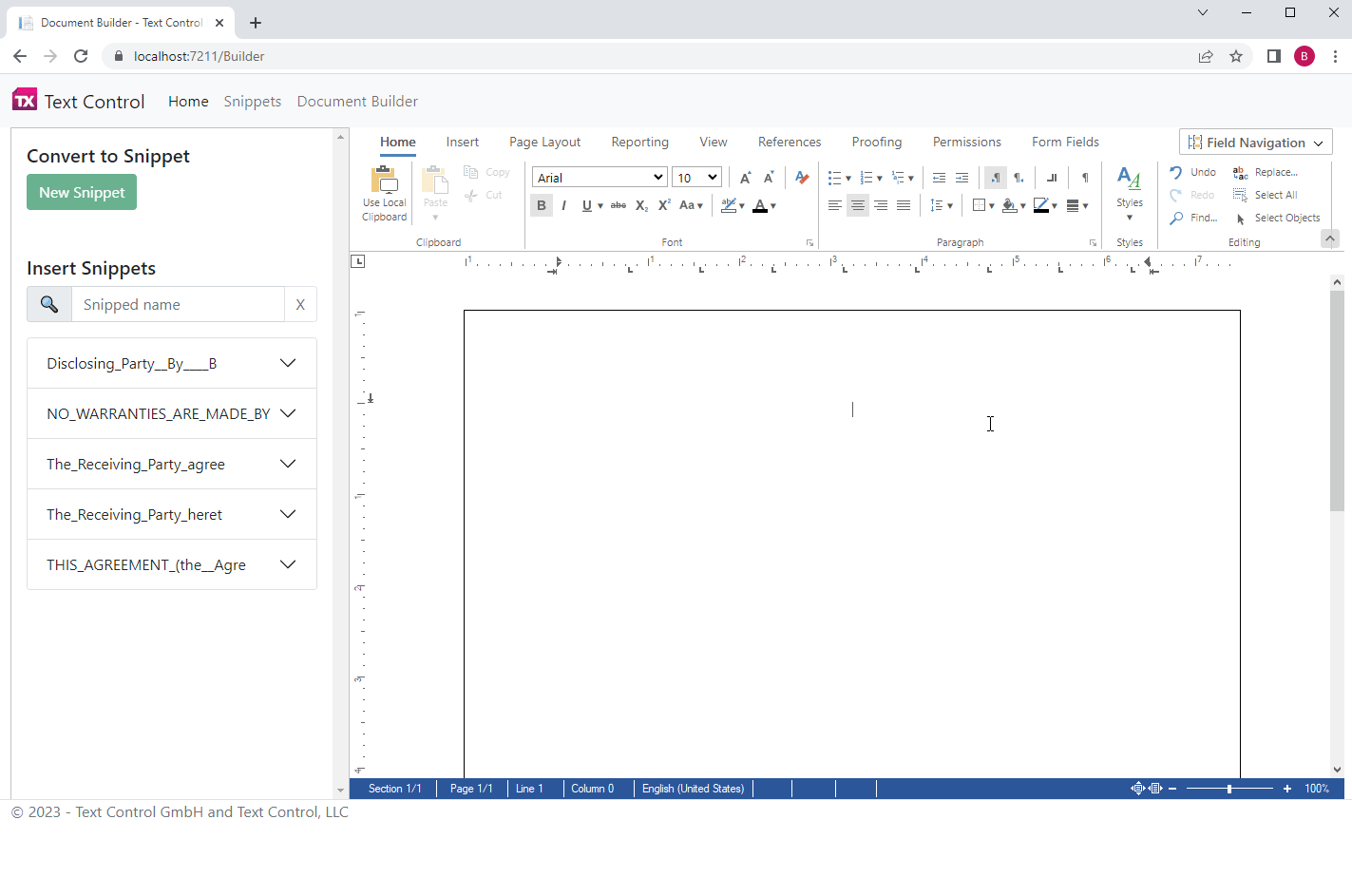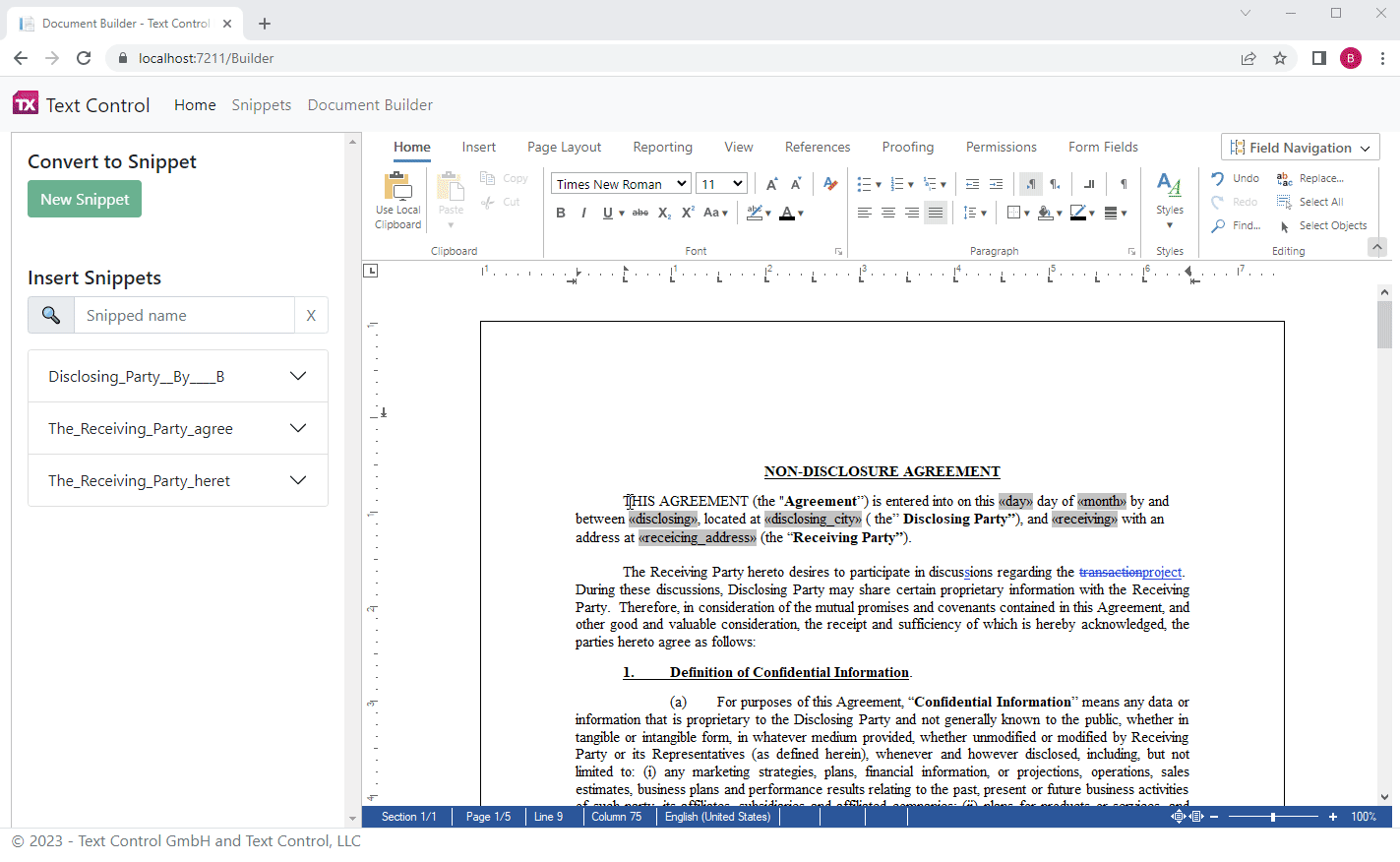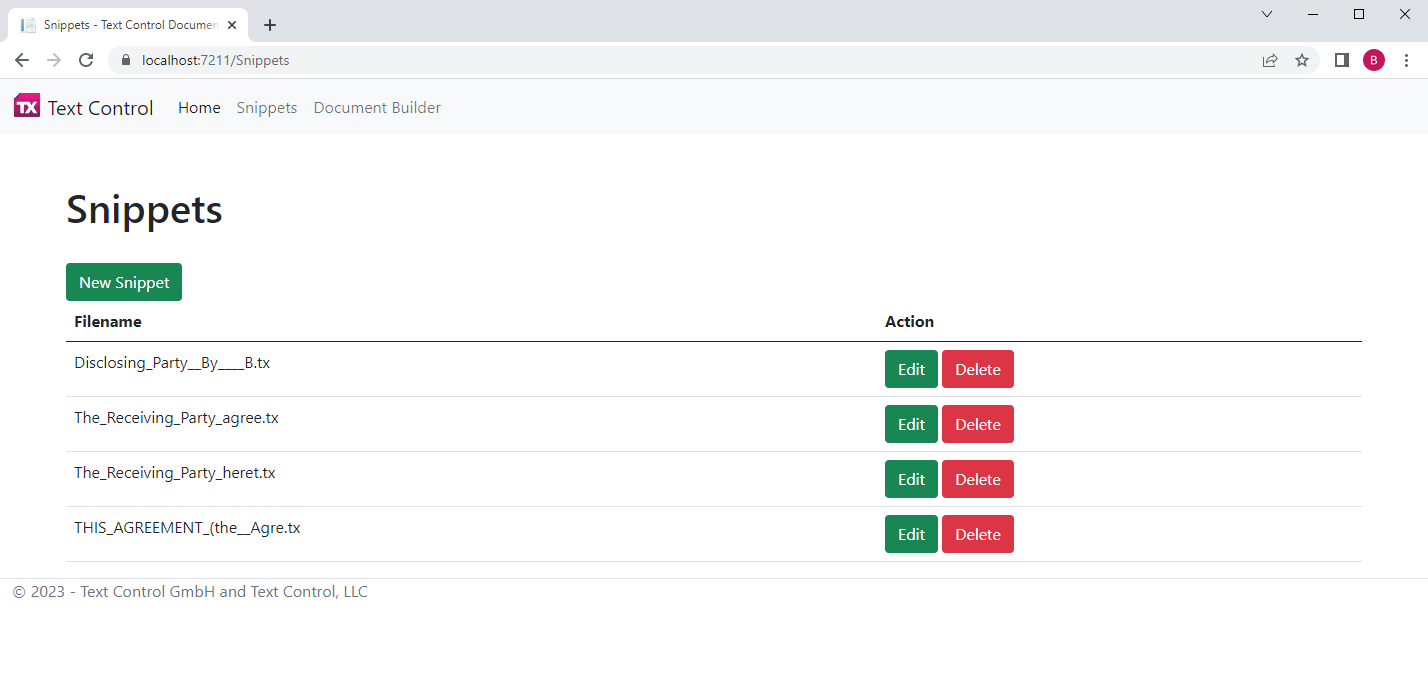Use and Create Reusable Formatted Text Snippets to Build Documents in ASP.NET Core C#
This sample implements a document builder that uses text snippets to create documents fast and efficient. Additionally, text snippets can be created and modified.

Manual document creation and processing is a high-effort process and error-prone. Information is manually typed into documents, older versions are reused (copy and change of existing documents) or documents are created from scratch each time a new document is required.
Contract Lifecycle Challenges
Specifically for business critical documents such as contracts and agreements, manual processes can be dangerous in many ways.
The following table lists typical challenges with agreement processes:
| Preparation | Collaboration | Signing | Managing |
| Errors due to manually entered data into contracts. | Usage of different "red-lining" tools and versions (MS Word). | No central portal to see status of the signing process. | Errors due to manually entered data into contracts. |
| Delays due to long preparation process. | No central control over tracked changes. | Delays due to missing information. | No central contract repository or search. |
| No data binding to CRM and ERP systems. | Poor user experience. | Delays due to wrong routing. | Security and data privacy |
For this sample, we take a look at the Preparation column and specifically the first reason:
Errors due to manually entered data into contracts.
To avoid this, reusable text snippets should be used and maintained at a central location. The following screenshot shows the sample that allows users to insert formatted snippets.

Creating Snippets
The interface allows users to create new snippets by selecting any text in the document and clicking New Snippet.

All elements are saved within the snippet including formatted text, merge and form fields, tables and other document elements. Technically, the snippet is saved using the Selection.save method and is stored server-side along with an HTML preview generated by TX Text Control.
[HttpPost]
public bool Create(string document, string name) {
var snippetName = _applicationSettings.SnippetDirectory +
"/" + Path.GetInvalidFileNameChars().Aggregate(name, (f, c) => f.Replace(c, '_').Replace(' ', '_'));
using (TXTextControl.ServerTextControl tx = new TXTextControl.ServerTextControl()) {
tx.Create();
// load the snippet
tx.Load(Convert.FromBase64String(document), TXTextControl.BinaryStreamType.InternalUnicodeFormat);
// select 200 chars as a preview
tx.Select(0, 200);
// save the body of the snippet
TXTextControl.SaveSettings saveSettings = new TXTextControl.SaveSettings() {
CssSaveMode = TXTextControl.CssSaveMode.Inline
};
tx.Selection.Save(out string htmlString, TXTextControl.StringStreamType.HTMLFormat, saveSettings);
TextReader reader = new StringReader(htmlString);
HtmlDocument doc = new HtmlDocument();
doc.Load(reader);
HtmlNode bodyNode = doc.DocumentNode.SelectSingleNode("/html/body");
System.IO.File.WriteAllText(snippetName + ".htm", bodyNode.InnerHtml);
}
// store the actual snippet in the Text Control format
System.IO.File.WriteAllBytes(snippetName + ".tx", Convert.FromBase64String(document));
return true;
}Loading Snippets
In case a snippet is inserted into the document, the Selection.load method is used to load the document asynchronously.
function getSnippet(snippetName, snippetFormat) {
var serviceURL = "@Url.Action("Content", "Snippets")";
console.log(snippetName);
$.ajax({
type: "POST",
url: serviceURL,
data: {
name: snippetName,
format: snippetFormat
},
success: successFunc,
error: errorFunc
});
function successFunc(data, status) {
if (snippetFormat == "HTM")
document.querySelector('[tx-snippet-name="' + snippetName + '"] .snippet-preview').innerHTML = data + "...";
else
TXTextControl.selection.load(TXTextControl.StreamType.InternalUnicodeFormat, data);
}
function errorFunc() {
$("#myToast .toast-body").text("Error! :-(");
$("#myToast").toast("show");
}
}Managing Snippets
The sample also implements an overview page that lists all created snippets.

This section allows you to edit and delete existing snippets and to create new snippets from scratch.

Test this on your own and fork our sample project on GitHub.
![]()
Download and Fork This Sample on GitHub
We proudly host our sample code on github.com/TextControl.
Please fork and contribute.
Requirements for this sample
- TX Text Control .NET Server 31.0
- Visual Studio 2022
ASP.NET
Integrate document processing into your applications to create documents such as PDFs and MS Word documents, including client-side document editing, viewing, and electronic signatures.
- Angular
- Blazor
- React
- JavaScript
- ASP.NET MVC, ASP.NET Core, and WebForms
Related Posts
ASP.NETASP.NET CoreDocument Automation
Why Document Processing Libraries Require a Document Editor
A document processing library alone cannot guarantee reliable and predictable results. Users need a true WYSIWYG document editor to design and adjust templates to appear exactly as they will after…
ASP.NETASP.NET CoreDocument Editor
Getting Started Video Tutorial: Document Editor in ASP.NET Core C# on Linux
This video tutorial shows how to use the Document Editor in an ASP.NET Core application using C# and deploy on Linux using Docker. This tutorial is part of the TX Text Control Getting Started…
ASP.NETDocument EditorDocument Protection
Document Protection in ASP.NET with TX Text Control: Healthcare Use Cases
This article explores document protection use cases in the healthcare domain. It also explains how to assign usernames, configure edit modes, and use editable regions based on user roles using the…
ASP.NETApp ServicesASP.NET Core
Deploying the TX Text Control Document Editor in an ASP.NET Core Web App to…
This tutorial shows how to deploy the TX Text Control Document Editor to Azure App Services using an ASP.NET Core Web App. The Document Editor is a powerful word processing component that can be…
Building an ASP.NET Core Backend (Linux and Windows) for the Document Editor…
This article shows how to create a backend for the Document Editor and Viewer using ASP.NET Core. The backend can be hosted on Windows and Linux and can be used in Blazor, Angular, JavaScript, and…






